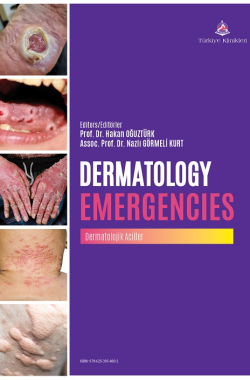DRESS (Drug Rash with Eosinophilia and Systemic Symptoms) Syndrome
Mehmet GÜLLÜOĞLU
Ministry of Foreign Affairs, Ankara, Türkiye
Güllüoğlu M. DRESS (Drug rash with eosinophilia and systemic symptoms) syndrome. In: Oğuztürk H, Görmeli Kurt N, eds. Dermatologic Emergencies. 1st ed. Ankara: Türkiye Klinikleri; 2025. p.49-51.
ABSTRACT
DRESS syndrome, or Drug Reaction with Eosinophilia and Systemic Symptoms, is a rare but potentially life-threatening drug-induced hypersensitivity reaction. Its incidence ranges from 1 in 1,000 to 1 in 10,000 individuals, with symptoms typically appearing 2-7 weeks after drug exposure. Common culprits include anticonvulsants, antibiotics, and other medications. The pathogenesis involves immune dysregulation, genetic predispositions, and delayed hypersensitivity reactions, often triggered by cytochrome P450 system metabolites. Diagnosis relies on clinical criteria, such as fever, rash, organ in- volvement, and hematologic abnormalities, often evaluated using the RegiSCAR scoring system. Management focuses on discontinuing the offending drug, supportive care, and corticosteroids or cyclosporine for severe cases. Despite a 10% adult mortality rate, children fare better with prompt treatment.
Keywords: Eosinophilia; drug hypersensitivity syndrome; drug eruptions
Kaynak Göster
Referanslar
- Cacoub P, Musette P, Descamps V, Meyer O, Speirs C, Finzi L, et al. The DRESS syndrome: A literature review. Am J Med. 2011;124(7):588-97. [Crossref] [PubMed]
- Dibek Misirlioglu E, Guvenir H, Bahceci S, Haktanir Abul M, Can D, Usta Guc BE, et al. Severe cutaneous adverse drug reactions in pediatric patients: A multicenter study. J Allergy Clin Immunol Pract. 2017;5(3):757-63. [Crossref] [PubMed]
- Kim GY, Anderson KR, Davis DMR, Hand JL, Tollefson MM. Drug reaction with eosinophilia and systemic symptoms (DRESS) in the pediatric population: A systematic review of the literature. J Am Acad Dermatol. 2020;83(5):1323-30. [Crossref] [PubMed]
- Wolfson AR, Zhou L, Li Y, Phadke NA, Chow OA, Blumenthal KG. Drug reaction with eosinophilia and systemic sympotms (DRESS) syndrome identified in the electronic health record allergy module. J Allergy Clin Immunol Pract. 2019;7(2):633-40. [Crossref] [PubMed] [PMC]
- Bayazıt EÖ, Nar C. Karbamazepine bağlı ilaç hipersensitivite sendromu. Turkderm. 2002;36(2):125-8. [Link]
- Kamijima M, Wang H, Yamanoshita O, Ito Y, Xia L, Yanagiba Y, et al. Occupational trichloroethylene hypersensitivity syndrome: human herpesvirus 6 reactivation and rash phenotypes. J Dermatol Sci. 2013;72(3):218-24. [Crossref] [PubMed]
- De A, Rajagopalan M, Sarda A, Das S, Biswas P. Drug reaction with eosinophilia and systemic symptoms: An udate and review of recent literature. Indian J Dermatol. 2018;63(1):30-40. [Crossref] [PubMed] [PMC]
- Kardaun SH, Sekula P, Valeyrie-Allanore L, Liss Y, Chu CY, Creamer D, et al. Drug reaction with eosinophilia and systemic symptoms (DRESS): An original multisystem adverse reaction. Results from the prospective RegiSCAR study. Br J Dermatol 2013;169(5):1071-80. [Crossref] [PubMed]
- Ben M'rad M, Leclerc-Mercier S, Blanche P, Franck N, Rozenberg F, Fulla Y, et al. Drug-induced hypersensitivity syndrome: clinical and biologic disease patterns in 24 patients. Medicine(Baltimore). 2009;88(3):131-40. [Crossref] [PubMed]
- Husain Z, Reddy BY, Schwartz RA. DRESS syndrome. Part II. Management and therapeutics. J Am Acad Dermatol 2013;68(5):1-9. [Crossref] [PubMed]

